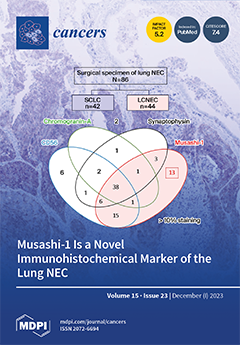Background: Germline pathogenic variants (PV) in
BRCA1 and
BRCA2 genes, which account for 20% of familial breast cancer (BC) cases, are highly penetrant and are associated with Hereditary Breast/Ovarian Cancer Syndrome. Previous studies, mostly including higher numbers of
BRCA1 BC patients, yielded conflicting
[...] Read more.
Background: Germline pathogenic variants (PV) in
BRCA1 and
BRCA2 genes, which account for 20% of familial breast cancer (BC) cases, are highly penetrant and are associated with Hereditary Breast/Ovarian Cancer Syndrome. Previous studies, mostly including higher numbers of
BRCA1 BC patients, yielded conflicting results regarding
BRCA1/2 BC outcomes. In the Portuguese population,
BRCA2 BC is diagnosed more frequently than
BRCA1 BC. We aimed to compare clinicopathological characteristics and prognosis between BC patients with
BRCA1 and
BRCA2 mutations and a control group without germline PV (
BRCA-wt). Furthermore, we explored the frequency and outcomes of risk-reducing surgeries in
BRCA-mutated patients. Methods: Prospective follow-up was proposed for patients with a diagnosed
BRCA1/2 PV. For this study, a matched control group (by age at diagnosis, by decade, and by stage at diagnosis) included BC patients without germline PV. We compared overall survival (OS) and invasive disease-free survival (iDFS) within the three groups, and the use of risk-reducing surgeries among the
BRCA cohort. Results: For a mean follow-up time of 113.0 months,
BRCA-wt patients showed longer time to recurrence (
p = 0.002) and longer OS (
p < 0.001). Among patients with
BRCA mutations, no statistical differences were found, although patients with
BRCA2 BC had longer iDFS and OS. Uptake of risk-reducing surgeries (contralateral prophylactic mastectomy and salpingo-oophorectomy) were negative predictors of invasive disease and death, respectively. Conclusions: Testing positive for a
BRCA PV is associated with a higher risk of relapse and death in patients with BC in the Portuguese population. Risk-reducing mastectomy and salpingo-oophorectomy were associated with lower incidence of relapse and longer median iDFS and OS, respectively.
Full article






